Eleven percent increase for schools since 2009-10? Not so much.
In his budget presentation to the State Legislature, Gov. Rick Snyder billed the education portion as making an investment in Michigan. He described increased spending on preschool – a good thing – and efforts to limit the costs of the public school employee pension system – the burden of which falls mostly on current and future retirees. But he also claimed that the state government had increased spending on K-12 education by 11% over the last four years, including his new proposal. He even had a slide to “illustrate” the point.
Now, with the Governor’s focus on being a “nerd,” and the budget materials all identifying him as a Certified Public Accountant as well as Governor, you might think that all these numbers pretty much reflect reality. But as we have learned over the last decade, to our cost, financial numbers can be “massaged” to tell different stories depending on the audience.
Gov. Snyder, CPA, was engaged in a litte bit of what they call “earnings management.” A closer look at K-12 spending shows a different, and more accurate, picture. We need to keep the true picture in mind as we discuss the performance of our public schools.
Here is the Governor’s slide showing per-pupil school aid appropriations:
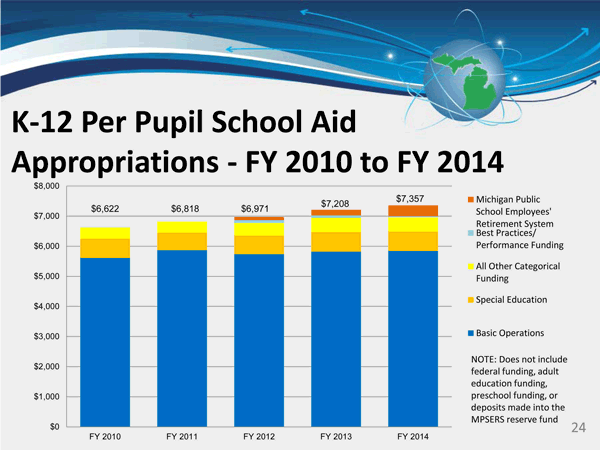
What’s missing
This chart tells only part of the story. First off, even the notes on the chart say that certain types of spending are not included. It is customary to exclude Federal funding from discussions of the school aid budget, because regular Federal dollars are tightly regulated and can be used only for specific purposes – so they are not available for general use. They also don’t form part of the state education budget, and so don’t reflect our own spending for schools.
However, Gov. Snyder, CPA, has also excluded Federal stimulus money from this chart. This money was designed to make up for tax revenue shortfalls at the state level and to prop up regular spending on education. In fact, were it not for that Federal assistance, a huge mid-year cut would have been required in the 2008-09 school year. The Federal stimulus money back-filled spending which the state had budgeted that year but was unable to deliver because of collapsing tax revenues. The Federal stimulus helped Michigan meet its budget; it did not allow us to increase spending more than planned. In the two following years, Federal assistance allowed Michigan to maintain more education spending than would otherwise have been possible, but still at reduced levels.
Front-load the bad news
Secondly, there’s a bit of “earnings management” going on here. The term “earnings management” refers to a practice private firms sometimes adopt to make their earnings seem smoother than they really are, or sometimes to concentrate all the bad news in one period so that later periods look better.
In this case, the governor, a former CEO, did a little of both. Huge cuts to K-12 education were concentrated in one year, FY 2011-12 (his first budget). School aid revenue that might have replaced the missing Federal assistance was instead used to support community colleges and state universities out of the School Aid Fund – now a permanent budget fixture. In addition, forecast increases to the School Aid Fund disappeared when the Michigan Business Tax was eliminated – along with the approximately $700 million it would have contributed to the School Aid Fund. School districts took large cuts to their foundation allowances in that year, changes which later became permanent.
On the other hand, some money was put aside in what can only be called a “cookie jar.” In FY 2012 and FY 2013, $133 million and $41 million, respectively, of School Aid Fund revenue was diverted into a “reserve” to pre-fund obligations of the state public school employee pension system (MPSERS). The governor’s chart, above, does not include these diversions as spending in the year they occurred, although they reduced the funds available for schools in those years. In his latest budget proposal, for FY 2014, the governor transfers $150 million from that MPSERS reserve fund into the school aid budget and (apparently) counts it as spending in the upcoming fiscal year. That’s not an increase in spending; it’s a shift in spending from two previous years (where funds were made unavailable to schools) into the next year.
Is this “sound fiscal management” or accounting hijinks for political effect? You be the judge.
A longer-term perspective on per-pupil state spending should take Federal stimulus funds into account, and shift the MPSERS reserve diversions into their proper years. Doing so presents this chart:
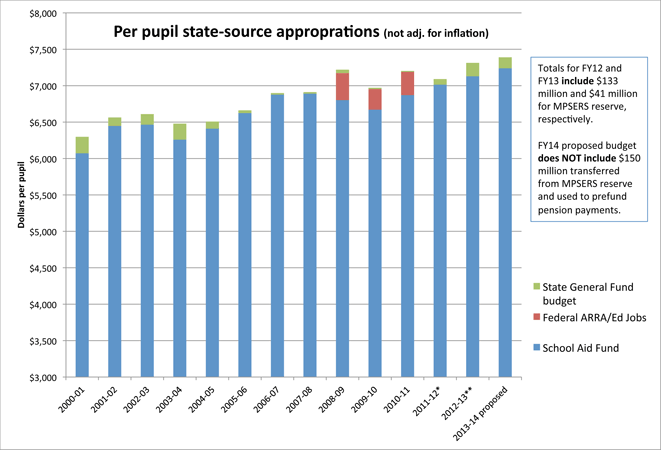
Looked at in this way, the importance of the Federal stimulus becomes obvious, especially since it replaced and did not add to funds the state had already committed to schools. The effective change in per-pupil spending is also rather less dramatic than in the governor’s formulation, though overall spending does increase (in current dollars).
Missing pupils
While at one level it’s fair to talk about education spending on a per-pupil basis, it’s also misleading in other ways – especially when the student population is declining. Schools receive their operating funds on a per-pupil basis; all of it, with no allowance for fixed costs. When a student leaves a school district, the district loses the $7,000 or so allocated to educate that pupil. However, the district does not realize $7,000 in savings from having one less student. It takes time to adjust to smaller student populations, and it is also imprudent to drastically downsize your district if the pupil declines may not be permanent.
So a look at overall state spending on K-12 schools is also in order, to show overall trends. Total state spending in current dollars is shown in this chart:
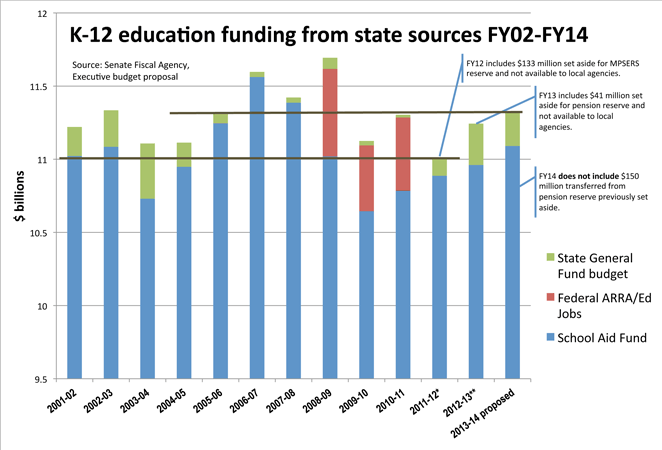
In this chart, the dramatic dip in state-source spending on education is clear to see in the 2009-10 fiscal year – the same year Gov. Snyder uses as the basis for comparison in his chart. Without Federal assistance, Michigan schools would have been hurt even more seriously than they were. Proposed spending levels for next year, though an increase compared to recent years, just reach the level of spending we had in FY 2006.
Whipped by inflation
No matter how you look at spending levels, by pupil or by overall level, the charts neglect one important fact: a dollar today does not buy as much as it did four, six, or ten years ago. To see the real impact of spending changes on Michigan schools, you need to take inflation into account. The accepted way to do this is to adjust spending by the Detroit metro area consumer price index. Twice a year, the chief economists from the governor’s office and the legislature estimate upcoming inflation rates as part of their consensus revenue estimates. In the following charts, we use actual inflation data and these estimates to show the “real,” or inflation adjusted, levels of spending.
First, let’s look at overall spending levels, adjusted for inflation:
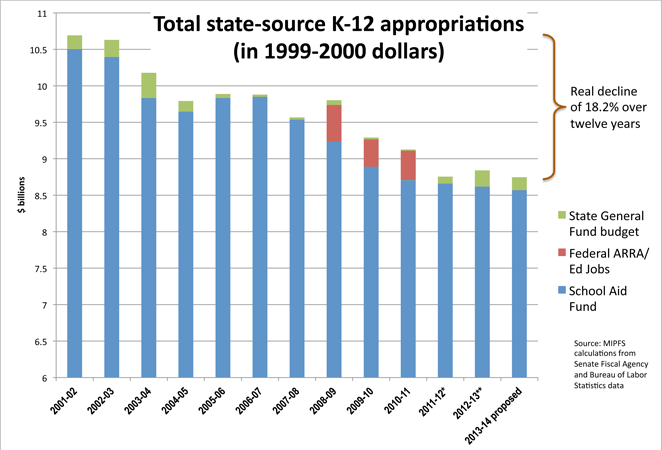
Including the governor’s latest proposal, overall state spending on K-12 education has declined by over 18% since FY 2012. This decline reflects both the “single state recession” Michigan suffered during the first decade of this century and the long-term decline in the revenues from taxes earmarked to support our schools. Gov. Snyder’s recent budgets have only roughly kept even with inflation, though with spending still at historically low levels.
Now, let’s look at spending levels per pupil, remembering that Michigan lost a good deal of its population during the Great Recession:
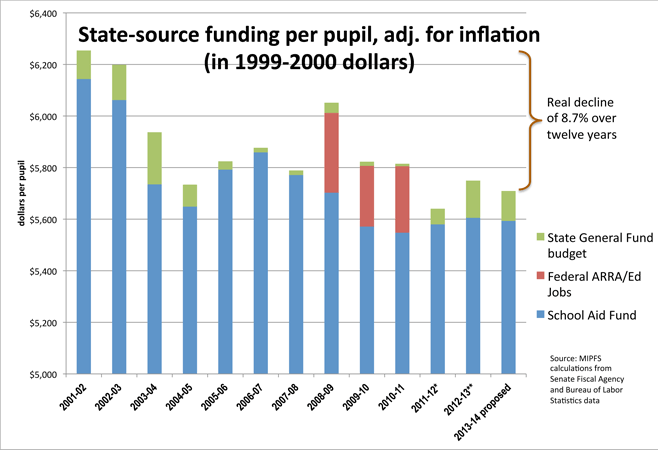
Real per-pupil spending took a dramatic decline in the early years of the last decade, and was holding at a lower level thanks in part to the Federal stimulus dollars. Even with modest recent increases, per-pupil spending has seen a real 8.7% decline since FY 2002. [The spike in per pupil spending in FY 2009 is partly explained by a planned budget increase later back-filled with Federal dollars and also by a dramatic drop in student population for that year.]
Current inflation-adjusted spending per pupil, including the governor’s proposed budget, remains lower than at any point since FY 2002.
Not exactly “throwing money” at schools
This funding history is important to keep in mind when we discuss proposed funding levels or the recent performance of our schools. While it is fashionable to claim that we have been “throwing money at the problem” of our public schools, in inflation-adjusted terms that simply is not true. In fact, adjusting for inflation understates the problem, since the contributions required to simply maintain the pension system or existing health benefits have increased much faster than inflation for the last decade or more.
When we consider what we expect our schools to achieve for our children, we also have to take a clear look at the resources our schools do, or do not, have available to get the job done. For a number of reasons, our school spending has not allowed schools to keep up with inflation, let alone keep up with the increasing costs of health care and retirement that affect our entire nation. Even compared with the size of the Michigan economy, our commitment to funding K-12 education has lagged in the last few years (the subject of a forthcoming article). Even well-funded school districts have been dismantling programs and increasing class sizes for years now. For those districts dealing with large at-risk populations of children, the impact has been devastating.
Our public schools must offer every child a quality education. They also need the resources to make that happen.
- Log in to post comments
